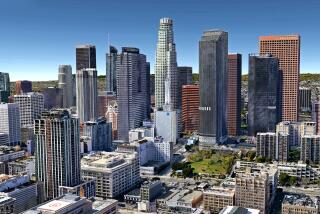Downtown offices are looking up
Even as the trendy loft and condo market cools a bit in downtown Los Angeles, the glass-and-steel skyscrapers are filling up and street life is picking up after dark.
Los Angeles architect Peter Devereaux is bringing his 150-employee firm to the heart of the city’s financial district. “We felt that now -- and more so going into the future -- that it would be to the advantage of our employees to be located downtown,” he said.
“It has all the amenities, like fitness centers, restaurants and entertainment.”
There’s no better indicator of commercial revival than the City National Plaza office complex, which for years stood as a mostly empty symbol of the challenges faced by downtown. Its profile looked impressive, but there were many vacant offices in the shiny towers. Now the complex is mostly full.
Downtown had languished since the early 1990s, when the region suffered a steep recession. Developers anticipating an office boom had built millions of square feet before the crash, and the city’s business district was left with a glut that only now shows signs of abating.
“Imagine every fourth floor was empty,” said broker Carl Muhlstein of Cushman & Wakefield. “We had a 25% vacancy factor.”
Today the numbers that commercial developers watch are encouraging them. Downtown vacancy rates are dropping and rents are heading upward, new statistics show. Landlords say they are bullish unless a swift downturn in the economy is ahead.
As the office market tightens across much of Los Angeles County, according to recent statistics, some of the biggest downtown landlords are raising rents -- something almost unheard of three years ago.
The county’s office market has been evolving in landlords’ favor for the last two years, said Muhlstein of Cushman & Wakefield, the brokerage that compiled the statistics. “Increases in rent during the last five years have greatly outstripped inflation,” he said.
For years, rents in vacancy-plagued downtown lagged behind those in other popular office markets such as Century City, Santa Monica and Burbank. That may be about to change, in part because City National Plaza is no longer dragging down the market.
Like a python that swallowed a pig, downtown has been trying to digest the two-tower complex since 2003, when Thomas Properties Group bought the landmark property occupying a city block on Flower Street across from the Central Library.
It had been one of the finest properties in the city for many years after it was completed in 1973 and became the headquarters of Arco, the petroleum company now owned by British oil giant BP. But it was maintained so poorly by its previous owners that it was no longer considered in competition with downtown’s good-quality buildings.
When Thomas Properties took over, the complex was close to 80% unoccupied, said Kent Handleman, a senior vice president at the Los Angeles company. Thomas Properties spent about $185 million to improve the neglected plaza and set out to snag tenants from every direction.
“We had to be very competitive,” Handleman said, which meant other downtown landlords couldn’t raise their rates much if they didn’t want their tenants to jump ship.
Now City National is mostly leased and the price war is over, Handleman said. “We used to be used as leverage against other landlords.”
With little more than the plush former Arco executive offices left to lease, Thomas Properties is raising rents and downtown’s two largest office landlords are among those following suit.
Rents downtown will go up 4% to 5% by the end of the year, predicted Bill Flaherty, a senior vice president at Maguire Properties, which owns the most downtown office space.
“Downtown was a bargain for so many years,” Flaherty said. “Now the Westside and other markets have had such rent increases that downtown is being pulled along with the strength of the overall L.A. County market.”
Average monthly office rents are $2.81 per square foot, up noticeably from $2.48 a year ago but still well below the $5 average in Westwood and Santa Monica, according to Cushman & Wakefield.
Consequently, “downtown is enjoying an influx of Westside tenants,” broker Muhlstein said.
Engineering firm Psomas will be heading there from West Los Angeles in December.
Investment banking firm Bear, Stearns & Co. recently opened a downtown office to complement its Century City branch.
Many other leases, however, reflect expansions of downtown local businesses or moves of a few blocks from one building to another.
“A lot of people on the Westside think downtown is dangerous, but here everything is new,” Handleman said, citing the $2.5-billion L.A. Live entertainment and hotel complex being built next to Staples Center and the recently opened Ralphs supermarket.
The 7,100-seat Nokia Theatre opened at L.A. Live recently, and construction is set to begin in December on the $2-billion Grand Avenue mixed-use development on Bunker Hill.
Doubts remain among some urban planners over whether these huge venues can actually help the surrounding sections of downtown grow and thrive, though. Many patrons simply drive in to see a concert and then drive out again, not stopping to participate in the night life of downtown.
Nevertheless, the construction boom that has added thousands of apartments and condominiums in the last few years is also changing the atmosphere by attracting more foot traffic and small businesses, observers said.
“It’s been an amazing transformation,” said attorney Mark Baute, who has had an office downtown since 1986 and recently signed another lease. “There is more going on.”
Condo sales have “been a little weaker” in recent months and some developers have brought their prices down or offered incentives such as discounted closing fees, said agent Kerry Marsico of Coldwell Banker. “But overall, prices are strong,” he said, and foreign buyers and wealthy individuals in particular are still very active.
Real estate broker Jonathan Larsen of Transwestern Commercial Services said he represented several Westside companies that were considering relocating downtown and estimated that a business that rented 50,000 square feet could save $1 million a year by doing so.
“But I’m still skeptical that the market is tightening the way big landlords think it is,” Larsen said. With downtown vacancy more than 15%, there are still a lot of offices to choose from, especially for smaller tenants, and much of the leasing still involves tenants moving from one downtown building to another.
“When somebody gets arrogant,” he said of landlords, “we look elsewhere.”
Downtown’s second-largest office landlord, Brookfield Properties, insists that the momentum is in owners’ favor. “This was the busiest summer any of us have ever experienced,” said Tony Manos, head of Southern California operations.
Among the tenants negotiating deals now are firms with leases that don’t expire until 2009. “Their advisors are sensing that rates are going to be very different in ’09 than they are today,” Manos said.
If the current trend does continue, Maguire Properties may break ground on the first new high-rise office tower downtown since 1992.
The real estate investment trust’s announcement last year that it was planning a building on Figueroa Street was greeted with skepticism, but Flaherty insisted the project was on track.
“We continue to work on it as a very real project,” he said. “If the market stays on course, we could break ground within two years.”
--
More to Read
Inside the business of entertainment
The Wide Shot brings you news, analysis and insights on everything from streaming wars to production — and what it all means for the future.
You may occasionally receive promotional content from the Los Angeles Times.











